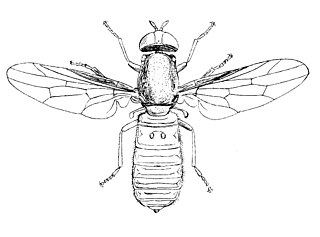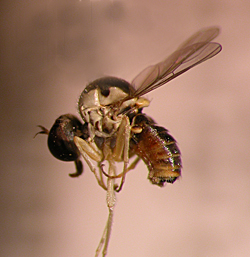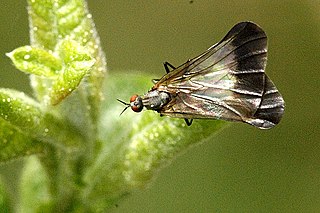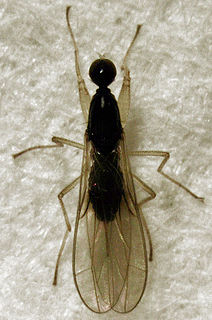
The Empidoidea are a large monophyletic superfamily of true flies, the sister taxon to the Muscomorpha (Cyclorrhapha). These two groups are sometimes united in the unranked taxon Eremoneura. There are some 10,000 known species within Empidoidea, which are represented on all continents except Antarctica. They are known to have existed since the Jurassic period.

Empididae is a family of flies with over 3,000 described species occurring worldwide in all the biogeographic realms but the majority are found in the Holarctic. They are mainly predatory flies like most of their relatives in the Empidoidea, and exhibit a wide range of forms but are generally small to medium-sized, non-metallic and rather bristly.

The Scenopinidae or window flies are a small family of flies (Diptera), distributed worldwide. In buildings, they are often taken at windows, hence the common name window flies.

Mythicomyiidae, commonly called mythicomyiids, are very tiny flies (0.5–5.0 mm) found throughout most parts of the world, especially desert and semi-desert regions, except the highest altitudes and latitudes. They are not as common in the tropics, but genera such as Cephalodromia and Platypygus are known from these regions. Many of these "microbombyliids" have a humpbacked thorax and lack the dense vestiture common in the Bombyliidae. Mythicomyiids have until recently not had much attention in the literature. Their small size has caused them to be missed when collecting. Yellow pan trapping and fine-mesh netting in Malaise and aerial sweep nets has resulted in a number of undescribed species from many parts of the world. A high diversity of both genera and species exists for this family in Africa, especially northern and southern portions. About 350 species are known. Hundreds more await description.
James Edward Collin was an English entomologist who specialised in Diptera.

Atelestidae is a family of true flies in the superfamily Empidoidea. The four genera were placed in a separate family in 1983; they were formerly either in Platypezidae or considered incertae sedis. While they are doubtless the most basal of the living Empidoidea, the monophyly of the family is not fully proven. The genus Nemedina seems to represent a most ancient lineage among the entire superfamily, while Meghyperus is probably not monophyletic in its present delimitation, and it is liable to be split up eventually, with some species being placed elsewhere. In 2010, the genus Alavesia, previously only known from Cretaceous fossils, was found alive in Namibia, subsequent species were also described from Brazil.

Trichopezinae are a subfamily of empidoid flies. They are mainly predatory flies like most of their relatives, and generally small to medium-sized, long-legged and large-eyed.

Dolichocephala is a genus of Dagger flies in the family Empididae. There are at least 40 described species in Dolichocephala.

Empis is a genus of dance fly, in the fly family Empididae. It contains the following subgenera and species:

Rhamphomyia is a genus of dance flies, in the fly family Empididae.
Edward Luther Kessel was an American biologist known for his work as an entomologist and writings to reconcile science and religion.

Hemerodromiinae are a worldwide group of predatory flies with raptorial forelegs.

Brachystomatinae is a subfamily of flies belonging to the family Empididae.

Clinocerinae is a subfamily of flies belonging to the family Empididae.

Empidinae are a subfamily of empidoid flies. They are mainly predatory flies like most of their relatives, and generally small to medium-sized. Most species are flower visitors and they can be effective pollinators.

Ragadidae is a family of true flies in the superfamily Empidoidea. It was formerly considered a lower taxon, but was published as a new subfamily within Empididae in 2016. Since then, it has been classified as the sister group to Empididae, and has been elevated to family level based on the genetic differences which separate it from Empididae.
Phaeobalia is a genus of flies in the family Empididae.
Wiedemannia is a genus of flies in the family Empididae.
Chelipoda is a genus of flies in the family Empididae.
Empis lindneri is a species of fly in the family Empididae. It is included in the subgenus Coptophlebia of the genus Empis. It is found in the Afrotropic.










